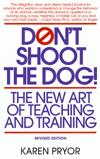Have you heard about positive training but aren’t sure what it is or how to get started? Trainer Eric Brad gives you a road map to success with four great books to get you on your way!
 Many people who do not use positive dog training have only a vague notion of what it is all about. Their attitudes vary from considering it a fad or passing fancy, to positive training being a scam where you just bribe the dog with food and cannot produce any solid or lasting training results. And this surprises me because positive training methods have been around for over 50 years, have been used on dozens of different species, and have produced some of the best animal “stars” for television, movies, and in all manner of dog activities.
Many people who do not use positive dog training have only a vague notion of what it is all about. Their attitudes vary from considering it a fad or passing fancy, to positive training being a scam where you just bribe the dog with food and cannot produce any solid or lasting training results. And this surprises me because positive training methods have been around for over 50 years, have been used on dozens of different species, and have produced some of the best animal “stars” for television, movies, and in all manner of dog activities.
The concepts and techniques positive trainers use are relatively simple and easy to learn. The confusion and misinformation that goes around in the dog world about positive training is amazing to me in light of how much information is out there on the subject. The claims by some that positive trainers can’t explain how they train behaviours likely comes from the fact that there are not ready-made sound bites to explain it. If you want to learn about positive training, you have to understand a few concept first. That’s not always quick but it’s pretty easy.
Another common belief is that positively trained dogs won’t work without their food or clickers. If that were true, it would be difficult to achieve much in dog sports such as Obedience, Agility, Herding, Ringsport, and others. But there are thousands of positively trained dogs that have reached the highest performance levels in their chosen sports without the need for food or clickers in the competition ring.
So maybe it’s just a lack of understanding that causes some people to dismiss positive training as a good choice for them and their dogs. I would suggest that maybe it’s worth a second look.
So How Do You Learn Positive Training?
Most dog owners were raised with training methodologies that were intended to correct unacceptable behaviours and steer the dog toward more acceptable behaviours. It’s an approach that has worked, after a fashion, for decades. For most, learning positive training requires a change in thinking at a more fundamental level than just what techniques you will use. You need to adjust the way you relate to your dog. You need to change your expectations of your dog and the results that training can produce. Most of all, you have to change your mindset from being reactive to your dog’s unacceptable behaviour to being proactive in teaching them the behaviours you want before they have a chance to develop unwanted habits.
It can be a lot to take in initially but fortunately, there are more and more positive trainers opening practices in communities all over the world. They will work with you and your dog to help you learn this fun, exciting, and very effective way of working with your dog. Because they compete with more traditional trainer, their fees will be in line with what you are used to paying but you may find that you are getting much more value for your money. And because so much of positive training is based on science, there is a wealth of information to be found in books that can help you understand the basic principles without having to deal with a dog at the end of a leash while you learn.
Getting Started
There are four books I consider essential for any positive trainer to have in their library. They cover different aspects of living and training with dogs. All four are well written and explore different but important aspects of positive training. I have included links to the descriptions below so that you can find out more about them. Each is a well established and prominent book that should be available at your local library or bookstore. All of these books are still in print and can be purchased at popular online booksellers such as Amazon and Dogwise.
 Don’t Shoot The Dog by Karen Pryor
Don’t Shoot The Dog by Karen Pryor
Karen Pryor began her career in animal training working with dolphins and other marine mammals. Many of us have seen dolphin trainers using a whistle while working with their animals. Don’t Shoot The Dog was first published in 1984 and is considered by many the first to bring the concepts used in dolphin training to dogs and dog owners. This book presents the theory and concepts behind positive training and behavioural science in a matter-of-fact and easy to read format. Karen Pryor clearly articulates the benefits and the need for positive training when working with animals. After all, dolphins, unlike dogs, have the option to swim away and you cannot simply control them with a choke chain. A great read that packs a great deal of information into a short volume, this book is my recommendation as an introduction to the concepts, philosophies, and rationale behind why positive training works. NOTE: This is not a how-to book so you won’t find instructions on training specific behaviours here. Find it at Dogwise.com
 Culture Clash by Jean Donaldson
Culture Clash by Jean Donaldson
More than any other book I have read, The Culture Clash set me straight on what dogs are and, more importantly, what they are not. Originally published in 1996, this book presents the scientific truth about dogs in an straight forward and unapologetic manner. Donaldson presents a picture of dogs as they really, with none of the “Disney” humanization that can give us a false view of dogs and their motivations. Aggression, housebreaking, chewing, and other common dog issues are all laid out and explained in an easily understandable way. The book addresses not just the basics about dogs, their behaviour, and instincts but also tackles common training and behaviour problem questions. This book changed how I looked at dogs and how I have dealt with them ever since. This is a book with more information per page than any other I can recommend. It’s worth reading more than once! A new “expanded edition” of this book was published in 2005. Be sure to get that edition. Find it at Dogwise.com
 The Other End of the Leash by Patricia McConnell
The Other End of the Leash by Patricia McConnell
This book by Patricia McConnell reminds us that there are two ends to every leash and that it’s important to understand why the parties on both ends of that leash do what they do. I found this book so valuable because it looks at what we humans do around our dogs and contrasts it with what our dogs probably make of all that. We are very different creatures, the human and the dog, and we each come with our own internal wiring. McConnell’s book looks at a variety of issues including how humans and dogs use their voices differently, why using “dominance” can cause more problems than it solves with many dogs, the differences in primate (human) body language and canine body language, and more. It’s a fascinating read as McConnell talks not just about the dogs but why we humans do the things we do around our dogs and why some of it helps and some of it hinders a good relationship. The book includes plenty of personal stories of McConnell and her dogs to illustrate her points and lends great credibility to what she puts forward. This book is a must for anyone who wants to understand our dog-human relationships. Find it at Dogwise.com
 How Dogs Learn by Mary Burch and Jon Bailey
How Dogs Learn by Mary Burch and Jon Bailey
Positive training is built on the well-understood principles of Operant Conditioning from modern psychology. Pioneered by B.F. Skinner in the 1930’s and 1940’s , Operant Conditioning has proven to be an incredibly successful behaviour modification tool for over 1000 species of animals from seals to rhinos, exotic birds to ferrets, hyenas to lions, and of course dogs. It is a science with its well defined terminology and processes and, while they are not complicated or difficult to learn, do some initial learning to become familiar with the concepts and terms. How Dogs Learn is the single best reference book I have come across for this. Written specifically for the dog trainer, this book takes all of the important concepts and terminology of learning theory and Operant Conditioning and lays it out clearly for dog owners and dog trainers alike. Read from beginning to end, it is a great introduction to the techniques of positive training but it is very valuable as a reference resource even for the skilled positive trainer. It is a book I keep on my shelf and find myself going back to time and again.
Find it at Dogwise.com
No Secrets Here
So, to counter the critics that say positive trainers don’t tell people how they do what they do, I would point out that there are literally hundreds of books on the market for using positve training with your dog, your cat, your parrot, and other pet animals. Positive training techniques have moved beyond the marine mammals at sea parks and into zoos where the techniques are used to make the animals more at ease with routine medical and maintenance procedures. Dozens of seminars and workshops are done around the world each year and attended by thousands who come to learn or sharpen their skills with positive training.
Far from keeping out methods “secret” as so many more traditional training outlets advertise (just search the Internet for “dog training secrets” and see what you find!), positive training has been out there in very public view for over 50 years. Most of us were taught the basics of it in college psychology courses. Most of us who use positive training aren’t out there bragging about our dogs because we’re too busy working with them and enjoying them. We don’t construct elaborate challenges to show that we are better trainers. And we certainly don’t spend our time proving that our dog can STAY better than your dogs. We would rather they do things. Lots of things. Things we teach them. Like being great companions.
So now you know how to get started! What are you waiting for?
Until next time, have fun training your dogs!
Photo credits –
Learning is fun – Sue Talbert Photography 2009 from Flickr
Learn Positive Dog Training [Feature image]- Texas Military Forces 2009 from Flickr




A so great article… Bravo Eric…et merci!
Well, I guess having 3 of the 4 is a good start though I have only read one of them completely through! Time to track down #4 and get cracking again at the other two. Thanks, Eric. Will be forwarding this link lots.